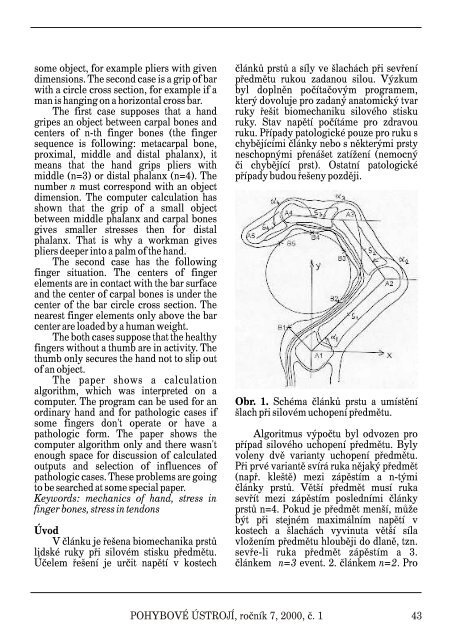1/2000 - SpoleÄnost pro pojivové tkánÄ›
1/2000 - SpoleÄnost pro pojivové tkánÄ›
1/2000 - SpoleÄnost pro pojivové tkánÄ›
- No tags were found...
You also want an ePaper? Increase the reach of your titles
YUMPU automatically turns print PDFs into web optimized ePapers that Google loves.
some object, for example pliers with givendimensions. The second case is a grip of barwith a circle cross section, for example if aman is hanging on a horizontal cross bar.The first case supposes that a handgripes an object between carpal bones andcenters of n-th finger bones (the fingersequence is following: metacarpal bone,<strong>pro</strong>ximal, middle and distal phalanx), itmeans that the hand grips pliers withmiddle (n=3) or distal phalanx (n=4). Thenumber n must correspond with an objectdimension. The computer calculation hasshown that the grip of a small objectbetween middle phalanx and carpal bonesgives smaller stresses then for distalphalanx. That is why a workman givespliers deeper into a palm of the hand.The second case has the followingfinger situation. The centers of fingerelements are in contact with the bar surfaceand the center of carpal bones is under thecenter of the bar circle cross section. Thenearest finger elements only above the barcenter are loaded by a human weight.The both cases suppose that the healthyfingers without a thumb are in activity. Thethumb only secures the hand not to slip outof an object.The paper shows a calculationalgorithm, which was interpreted on acomputer. The <strong>pro</strong>gram can be used for anordinary hand and for pathologic cases ifsome fingers don't operate or have apathologic form. The paper shows thecomputer algorithm only and there wasn'tenough space for discussion of calculatedoutputs and selection of influences ofpathologic cases. These <strong>pro</strong>blems are goingto be searched at some special paper.Keywords: mechanics of hand, stress infinger bones, stress in tendonsčlánků prstů a síly ve šlachách při sevřenípředmětu rukou zadanou silou. Výzkumbyl doplněn počítačovým <strong>pro</strong>gramem,který dovoluje <strong>pro</strong> zadaný anatomický tvarruky řešit biomechaniku silového stiskuruky. Stav napětí počítáme <strong>pro</strong> zdravouruku. Případy patologické pouze <strong>pro</strong> ruku schybějícími články nebo s některými prstyneschopnými přenášet zatížení (nemocnýči chybějící prst). Ostatní patologicképřípady budou řešeny později.Obr. 1. Schéma článků prstu a umístěníšlach při silovém uchopení předmětu.Algoritmus výpočtu byl odvozen <strong>pro</strong>případ silového uchopení předmětu. Bylyvoleny dvě varianty uchopení předmětu.Při prvé variantě svírá ruka nějaký předmět(např. kleště) mezi zápěstím a n-týmičlánky prstů. Větší předmět musí rukasevřít mezi zápěstím posledními článkyprstů n=4. Pokud je předmět menší, můžebýt při stejném maximálním napětí vÚvodkostech a šlachách vyvinuta větší sílaV článku je řešena biomechanika prstů vložením předmětu hlouběji do dlaně, tzn.lidské ruky při silovém stisku předmětu. sevře-li ruka předmět zápěstím a 3.Účelem řešení je určit napětí v kostech článkem n=3 event. 2. článkem n=2. ProPOHYBOVÉ ÚSTROJÍ, ročník 7, <strong>2000</strong>, č. 143
















